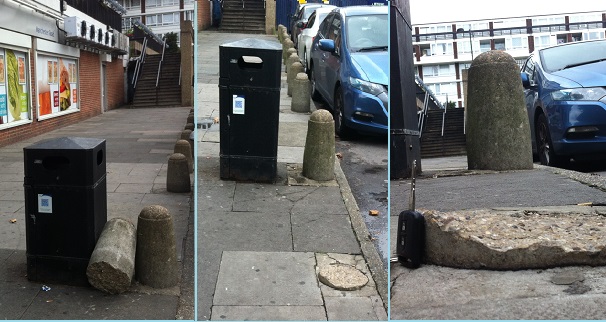As soon as they heard that One Housing Group is planning to redevelop all four of its housing estates on the Isle of Dogs, local residents began asking whether the housing association was competent to undertake such a large project. After all, it had just managed a major works programme which had been carried out with no prior consultation with residents and had included such gems as front doors being repainted while they were shut, electrical upgrades which had to be done again as they were found to be substandard and the infamous painting over of a snail which chose to have its morning stroll just as the painters were doing the railings.
Now a new issue has come to light, in the form of a bollard outside the Nisa shop on Manchester Road, at the entrance to the Samuda estate. The bollard had led a peaceful existence for most of its life, blending quietly into the background. Unfortunately, some six months ago a passing lorry did not see past the camouflage and booted the bollard off its perch.
The owner of the Nisa shop rescued the bollard from the gutter and carefully placed it on the kerb, wedged between another bollard and a litter bin – where it remained. As we took some photographs with a view to reporting on the ballad of the bollard, we were approached by two, separate, unconnected residents. One claimed that the bollard had been broken for seven months and he had reported it to One Housing Group (OHG), the estate’s landlord, on their central phone number. He had also said that he had stopped men who were in OHG uniforms and were connected with a fleet of OHG vans stored in the nearby underground garages and had asked them if they would report the bollard: they refused. A second resident stopped and told us he had reported the bollard to the local office, at least three months ago. We have no way of verifying these reports of course, but they were entirely unsolicited. One Housing Group regularly inspects the estate to find any faults in communal areas – but somehow this process did not lead to the broken condition of the bollard being detected and no one came to fix it. As well as the broken top of the bollard lying around – quick a missile, should anyone find they needed one, there was also the broken bollard bottom, which was a significant trip hazard.
OHG provided the following comment on the situation.
“We are able to confirm that the bollard was accidentally damaged by a delivery van relatively recently, however we have checked our records and the incident was only reported to us on Monday of this week (10th August).
“It’s concerning that you say it has been outstanding for several months and that residents claim to have reported it repeatedly but our records aren’t consistent with that account unfortunately. If you can supply details of previous reports we would be happy to investigate further as to why those reports appear not to be in our systems.
“However, I am pleased to say that following the report on the 10th our repairs team were able to complete remedial works on Thursday 13th August so the problem should now be resolved.”
What did OHG’s comment that “our repairs team were [sic] able to complete remedial works on Thursday 13th August” mean? It would seem that they were saying that they had mended the broken bollard, and we returned to the site to have a look at the repaired bollard.
We were to be disappointed. The bollard which had spent either months or days looking back at its former footing and hoping to return to an upright position was… GONE! It seemed to be more a case of “we have moved the bollard” than “we have mended the bollard”. In any event, the residents of the Samuda estate remain without a bollard: the bollard row along this kerb stopped a bollard short.
What is worse is that the broken bollard-footing remained. The protrusion was a good inch high – and was very difficult to see as it blended into the colour of the surrounding pavement. It was definitely a trip hazard (as it was before it was “repaired”).
This opened up a new problem area. Initially this was a dangerous bollard-footing that, we assumed, no one from OHG had seen. Now, OHG have provided a public statement that their repair team has been in the area. It is not a big area. The repair team must have seen the broken bollard footing on their visit – it was only a couple of feet from where the broken bollard top had been put, the one that they had moved. Why were OHG insisting that remedial works had been completed. Were they speaking in ignorance of the facts – which is not what you want from a landlord. Or perhaps it was that their interpretation of “mended” does not match with common parlance and was intended to refer to what the rest of us call “moved”.
When this was put to OHG, they came up with the following statement.
“Thank you for highlighting this issue. We have done further investigation and established that the operative who was sent to make the necessary repairs on 14 August was unable to do so as a parked car was blocking access. We are continuing with work to address the problem however and are in the process of ordering a replacement bollard and will put a parking restriction in place to ensure that replacement can go ahead once it arrives.
“In the meantime, an operative will visit the site again today to take the remaining part of the bollard safely down to ground level to remove the trip hazard or, if this is not possible, tape off the area to highlight the risk until we can complete the remedial works.
As you know, pending the full deployment of our own operatives through One Direct, we are still largely dependent on external contractors for this kind of work and despite our best efforts, we are unable to verify completion of as many repair tasks as we would like. So thank you for bringing this to our attention so that we can take the further action necessary.”
We visited again, and the bollard stump has indeed been ground down and the resulting cavity has been filled with sand. As for how a landlord can confirm that a repair has been done when it has not been done, that still leaves us baffled. We are similarly baffled by the explanation that the operative could not repair the broken bollard footing because “a parked car was blocking access”. It may well have been the case that a car was parked on the road, by the kerb – blocking access to the bollard footing from the kerb side. However, the bollard is surrounded on three sides by a paved area, from which access could easily have been obtained.
Unfortunately, one bollard was harmed in the making of this story – but we look forward to the arrival of its replacement.
[Adverts]
 East London News A Force for the community…
East London News A Force for the community…




